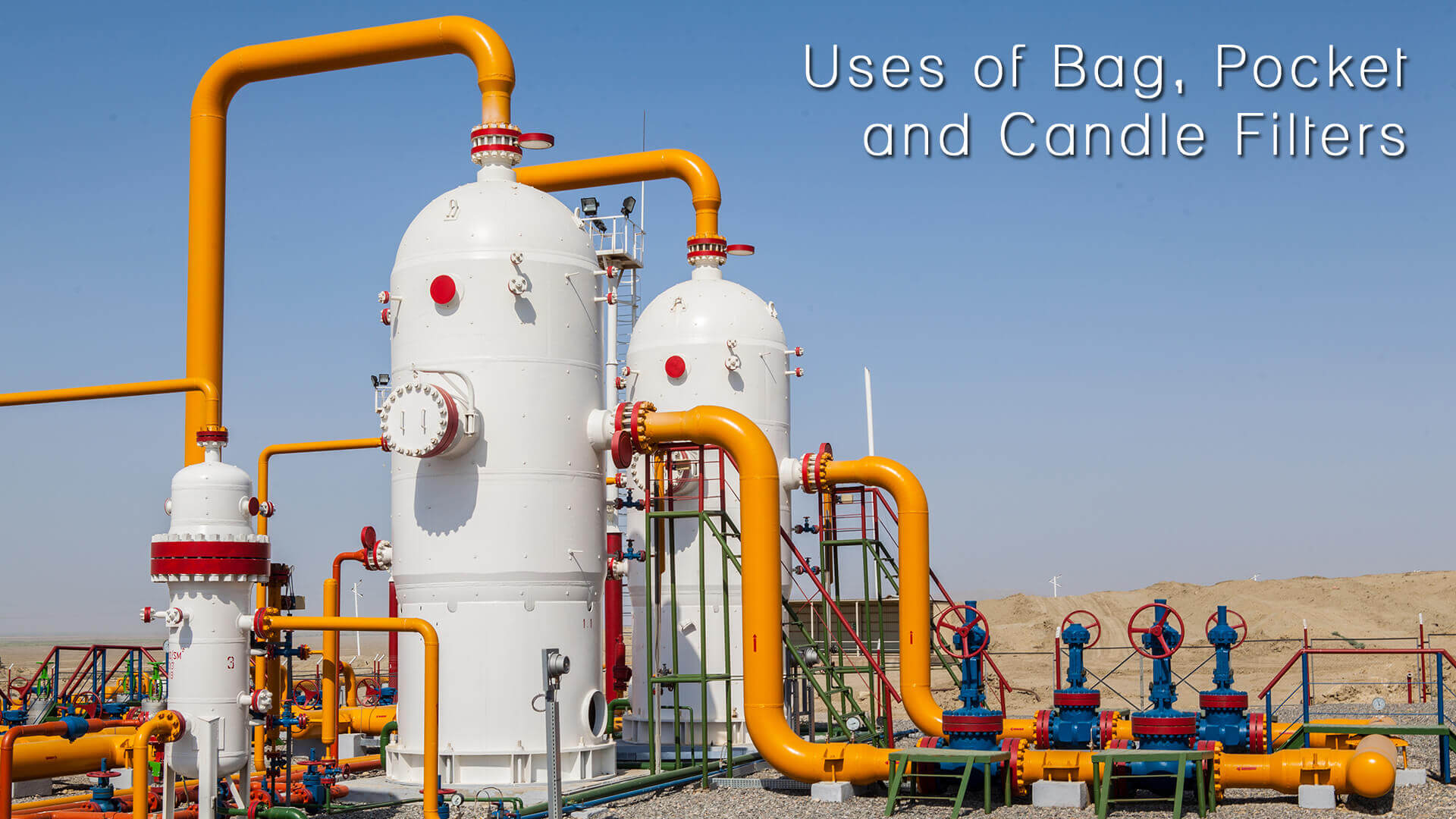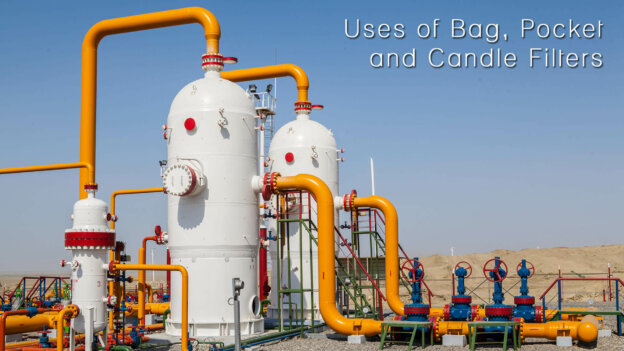
Every dry filtering process, which relies on pads and panels as a means to capture dust, has a flat filter surface or a pleated medium panel. These capture the dust on the surface. However, this section covers those filter types that capture the dust inside or on the exterior surface of a generic bad-shaped, circular or elongated oval cross-section. Within this category, there are three sub-categories:
- The Filter Bag
- The Filter Pocket
- The Filter Candle
All three of the above-mentioned filters are significant components of the dust collection equipment spectrum.
The Filter Bag
Not only is this filter used for the purpose of dust collection, but it is also used widely for liquid clarification. While processing several materials, filter bags serve as quite an efficient filter in extracting particulate contaminants. The process of bag filtration is through the application of pressure, during which the desired product is forced through the filter unit. In most cases, the unit consists of the filter housing, retainer basket and the filter bag. However, this composition is used for an increased amount of filtering than that for which strainers are used. Filter bags prove useful for solid particles that range from 1-1200 micrometer in size and have flow rates between 1 and 1000m 3/hr. Furthermore, they are more effective where the solid concentrations are comparatively lower.
The materials used to make these filter bags include woven mono, multi-filament fabrics, needle felts, meltdown, non-woven fibers, nylon, polypropylene, polyester, porous PTFE fi lm and other fluoropolymers, viscose, aromatic polyamides, felts and woven wool.. They are fastened through a top seal arrangement that ensures location permanency and sealing into the specific housing vessel. Keeping in mind the high level of differential pressures that could the bag potentially encounters, there is usually a provision for a support framework, such as a cage made of metal rods or a perforated/ wire mesh metal basket. This basket is deployed to ensure that the bag stays in position and protects from bursting due to increased pressures. The flow of the liquid usually comes from inside the bag to outside, and the filtering process is undertaken within the inner face of the bad, mainly through surface filtration and then cake formation. This is compounded by a degree of depth filtration with felted media.
Once the contaminants are extracted, they are collected on the outside of the bad, from whence it can be blown, through reversed liquid flow, which then accumulates at the bottom of the housing and is blown out at regular intervals. Although fairly popular, the presence of uneven porosities that were causing holes in the stitched seam, made the demand for filter bags reduce considerably in recent times. This resulted in the manufacturing of a seamless filter bag, which then brought filter bags back up to the top of the demand list. Another common type is the one piece glass-reinforced polypropylene all-plastic bag filters that are highly resistant to corrosion and have the ability to replace relatively more expensive filters with plastic-lined housings across various applications. Moreover, they can handle temperatures over 50% higher than those of PVC filter tolerance. Majority of the liquid bag filters are designed with a single bag for a single housing type, and a drop in pressure is indicative that the filter has reached its maximum dirt holding capacity and therefore, needs to be stopped. Hence, bag filters are also used as a polishing aid for duplex homes with two bags alongside each other and piped together.
Dust capture, either inside the bag or outside is a common occurrence and dust cakes formed on the outside are more easily removed by a thorough shake of the bag assemblage or by reversed flow of compressed air. This dust then falls into the hopper that is installed at the base of the bag. The dust that accumulates inside the bag is similarly shaken into the bottom of the bag, but the extraction requires a temporary cessation of the filtering process, while the bags are extracted to be emptied and cleaned.
The bag is manufactured with a high rate of elasticity, such that the pulsed jet will end up causing a slight expansion in the bag and crack the dust cake, causing the dust to be released in a fairly easy manner. When selecting a bag, it is prudent to keep in mind the characteristics of dust that will be filtered and then choose the bag of the appropriate material that suits the specific dust filtering process as optimally. The main factors to consider are the dust particle size and density, their abrasiveness and the hygroscopicity and tendency to develop aggregates. Further, the electrical properties of the particles should also be considered, with special attention given to an explosive potentiality. If the particle has any explosive potential, anti-static mediums of bags are ideal. These are bags that are made up of synthetic fibers and interwoven with metallic or carbon fibers that carry an earthed connection. The selected fabrics can be further functionalized through treatment for water repellence, fire resistance and special empowerments that enhance filtration and provide easier cake release.
Initially, bag fabrics were predominantly woven fabric of natural fibers. However, with the onset of felts of sufficient strength, the equation shifted in favor of the latter, due to their economic advantage. Additionally, there homogenous ability allows them to retain dust at a greater capacity and at lower pressure drops. However, the increased depth in filtration consequently requires a more thorough cleaning action. Synthetic nonwoven fabrics, such as spun bond and SMS sandwich media also make up a significant component of baghouse filters, wherein they are pleated to increase the filtration area. They are protected by a layer of highly coarse mesh that maintains the position of the pleats during a backflush.
Exhaust gases require PTFE or Teflon as their material due to the heat associated with this filters. Another new component is Telfair, which is a blend of 25% needle felt and 75% Teflon fibers. Other than this, polyimide fibers also have high temperature resistance that work well in mineral processing and cement production exhausts.
Finally there is an exclusive material that can be employed in similar structures and layouts, which is called the rigidized medial element. This element is flat, unlike the flexible fabric-style medium, and has two long porous plastic sheets that join around its edges.
The Filter Pocket
As the name suggests, this filter is made up of two rectangular sheets that are placed alongside each other and merge at three edges, leaving the fourth one open. They are primarily used for air cleaning. The pocket panel usually consists of 4-8 pockets installed at different points, providing a much higher filtration area than the face area of the panel. Even though the material of the pocket needs to be stronger than the pleated panel, there is a wide variety of synthetic fibers that can efficiently do the job.
The filter pocket is usually made up of multi-layer constructions, wherein the inner layer that faces the incoming air has larger pores intended to capture the coarser particles. This is followed by a middle layer that is intended for finer filtration and finally an outer layer that prevents fiber migration from the pocket. The pocket filters closed ends extend themselves onto the outer backward panel into the clean air space. They are routinely removed for cleaning or replacement.
The Candle Filter
For the purpose of this article, the context of the candle filter is a process filter that is used primarily in the recovery of process residues from liquid streams. They are mostly made up of vertical cylindrical structures, within which a number of cylindrical filter elements are suspended from a tube plate and are closed at the bottom end. The flow of liquid takes place from the outside to the inside and thereafter, through the upper open end of the cylinder and into the filter space that rests above the plate. The structure is predominantly a rigid and smooth surfaced tube that is made up of porous metal, plastic or ceramic. These filters are optimal for low levels of particle size and are also self-supportive in nature by resisting fairly strong pressure drops.
Candle filters that are made up of the ceramic materials are commonly used for filtering aggressive gases and hot corrosive liquids. However, the term candle filter is generally used for any form of multi-tubular filters that is incorporated with hanging elements.

